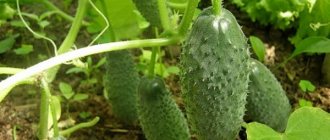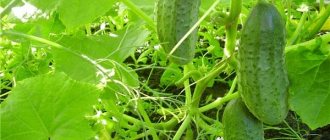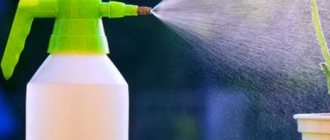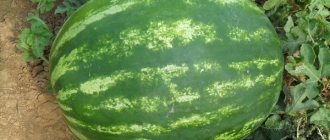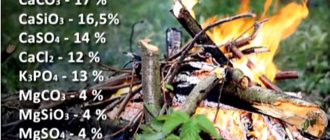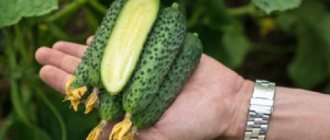» Vegetable growing » Cucumbers » Cucumber variety Emerald earrings
0
2043
Article rating
Emerald catkins cucumbers got their name due to the large number of nodal ovaries. Ripe fruits hang in clusters, resembling birch earrings. The variety was bred by Moscow breeders; it has been included in the register of the Russian Federation since 2011. The fruits are suitable for eating raw or canning. It can be grown both in greenhouses and in open ground.
- Advantages and disadvantages
- Rules and terms of landing
- In a seedless way
- For seedlings
- Care
- Reviews from gardeners
Cucumber variety Emerald earrings
Description of the variety
Cucumber f1 emerald earrings is a hybrid variety that was bred by Russian breeders, namely Moscow Agro. In 2011, this variety was included in the State Register of Russia and provided recommendations on how to grow it in various regions of the country in open and closed areas.
The cucumber variety Emerald Earrings is an early hybrid that grows 42-45 days after the shoots appear. The plants themselves are medium in size with a female flower, each of which has 8-10 ovaries in each node. The fruits are short - 9-11 cm (technical maturity of the fruit). All greens have high taste and food quality. A distinctive feature of the variety is its versatility and profitability. Its yield is simply fantastic - 11-12 kg from 1 m2! The fruits appear together, there are many ovaries in the nodes, and this allows you to collect 6-7 kg of cucumbers from one plant. This is why cucumber is so popular.
Pest treatment
In addition to vegetable crops, pests also find greenhouses comfortable. And although autumn disinfection is a very effective procedure, there is a possibility of contamination of the greenhouse during the growing season. Therefore, we will consider emergency measures to combat them:
Greenhouse whitefly
To avoid re-infection, mosquito nets are placed on doors and vents for ventilation. During the control process, weeds are carefully removed and glue traps are placed. For spraying, use a tincture of dandelions and roots, keep it for 2 hours, then filter it and immediately begin spraying the cucumbers. A tincture of crushed garlic, aged for several days, is also suitable; the solution is diluted and filtered before use.
melon aphid
As with Whitefly, weed removal will help reduce the population. Cucumber Emerald Earrings are treated with 200 g of red pepper and 30 g of tobacco dust, per 10 liters. hot water. After leaving for 24 hours, mix well, add 1 tbsp. l. Liquid soap and 3 l. Wood ash. A week after treatment, a fixing spray is applied to finish off the most tenacious ones.
Slugs
They can be dealt with mechanically: they create traps from damp rags, boards, polyethylene, etc., where the slugs will be comfortable, then they are collected and destroyed. The parasitic nematode is used as a biological agent against slugs. The bacteria are diluted in water and watered on the cucumbers, after which the slugs do not return to the open area for a month and a half, and it is more difficult for them to get into the greenhouse. And finally, the chemical Thunderstorm, which is scattered around the area. It stimulates the secretion of glands in slugs and snails, causing them to dehydrate and die.
Cucumber Emerald Placer F1. Search
Cucumbers German F1 - reviews, description
Several tons of cucumbers were collected by a family from the Vologda region
In addition to the described pests, spider mites and mole crickets like to spoil the lives of cucumbers. The mite is eliminated by maintaining good air humidity; it prefers an arid environment and infects cucumbers during this period. The mole cricket, on the contrary, loves moisture; it is poisoned by adding soapy water and vegetable oil to the burrows, and is also destroyed when discovered. Among chemical agents, Medvetox, Grizzly, Thunder, Boverin and others may be suitable.
Characteristics of the variety
You can plant such cucumbers:
- in open ground;
- in greenhouses;
- under temporary film shelters.
Emerald earrings cucumber variety is considered a salad, parthenocarpic, and canning variety. As for the bush of this plant, it is vigorous. It is a hybrid, indeterminate plant crop with female flowering varieties. In each node the number of female flowers reaches 2-3 pieces. The arrangement of the ovaries is considered a bouquet. The leaves are green, rich in color. They are medium size.
Benefits of plant culture
The attractiveness of the Emerald earrings variety lies in the following:
- That the plant has a high yield. According to reviews from farmers who have already grown them, from 1 m2 you can harvest at least 11 kg of cucumbers. A large number of ovaries are formed in the nodes, and fruiting is very friendly.
- The plant is medium-branched, which greatly simplifies the care of vegetables. The first harvest can be harvested 45 days after emergence.
- Gardeners highly value this crop because it allows you to collect both ripe gherkins, about 5-8 cm long, and provides an excellent collection of pickles, the sizes of which vary from 3 to 5 cm.
- The Emerald Earrings variety allows gardeners to collect neat and even greens. Their shape is smooth, regular, cylindrical. On the surface of the fruit there are very prickly white spines and medium-sized tubercles.
To avoid damaging the skin of your hands, it is recommended to wear gloves when picking cucumbers of this variety.
Agricultural technology
In terms of fruiting and taste, the cucumber crop Emerald Earrings is beyond praise, but it must be cultivated correctly and wisely.
The seeds of the plant do not require additional treatment in the form of soaking in stimulating preparations, as they undergo full pre-planting preparation from the manufacturer. The seedling period is almost no different from the cultivation of other cucumber varieties. As usual, cucumber seedlings are grown in separate containers so as not to disturb the roots when transplanting. Note! Hybrid Emerald catkins can be cultivated in the garden, but still, in greenhouses it will be much easier for it to reveal its full potential and produce the maximum amount of greenery per season, until late autumn.
1.5-2 weeks before planting seedlings, additional fertilizers must be added to the soil of the greenhouse:
- 12 kg of compost;
- 2 tbsp. l. complex minerals per m2 of plantings.
Water the bed well 4 hours before planting. Cucumber seedlings are planted in one row with an interval of at least 400-500 mm from each other. High air humidity (up to 90%) is required for the formation of ovaries in the nodes. The air temperature should be approximately +28 °C for flowering, and about +30 for fruit production.
As soon as there is persistent warm weather outside, it is important to tie the plants to the trellis. To do this, correctly pull two wires at a height of 2 meters parallel to each other, at a distance of 300-400 mm
The rope is attached on one side to the wire, on the other side at the bottom of the seedlings. The next bushes are tied in the same way, but to another parallel wire and alternately. Twice a week, the rope must be wrapped around an upward cucumber bush.
Formation
First of all, you should mentally divide the entire hybrid bush into 4 zones vertically.
In the first zone from the ground, which includes the first 4 leaves, it is necessary to remove all shoots and female flowers in the axils of the foliage. After the first bunch of the plant has formed in the next 2nd zone, pinch the shoots from the side, but leave 2 leaves on them. In the third zone, you also need to pinch all the shoots on the side, leaving only 3 leaves on them. At the time when the main shoot in the center grows to the wire on top:
- it is wrapped around her;
- After waiting for several leaves and a bunch to grow on top, the top of the main shoot should also be pinched.
It is necessary to water the hybrid every day in the heat and only with strictly warm water.
It is important to feed with organic matter every 14 days.
Note! Bird droppings must be diluted 1:20, mullein 1:10. Fertilizing cucumbers is introduced immediately after watering.
During flowering, the cucumber hybrid Emerald Earrings will not be hindered by treatment with anti-stress compounds such as Epin, Zircon, HB-101.
How to create a feeding schedule for seedlings
During the growing season, the hybrid requires certain vitamin and mineral compositions. Feeding schedule:
- At the beginning of the growing season, cucumber absorbs nitrogenous substances more intensively.
- During the growth of lashes, potassium elements are vitally needed for seedlings.
- With the new formation of shoots and the beginning of fruit production, an additional need for nitrogenous preparations appears.
In total, the effective ratio of nitrogenous, phosphorus and potassium substances in cucumbers is intended by nature in the following ratio: 2:1:3.
During the flowering period, certain fertilizers are used. The most relevant are the following:
- Add a spoonful of potassium sulfate, superphosphate and urea to a bucket of water.
- 250 g of liquid manure.
- 1 spoon of sodium humate per bucket of water.
And hybrids experience the greatest need for feeding and watering during fruit production. Both root and foliar fertilizer with minerals are important, and organic matter is applied immediately under the rhizome. So, during the period of fruit release, they feed three times:
- 250 g of mushy chicken droppings or one tablespoon of nitroammophoska per half bucket of water.
- A week and a half after the first fertilization, dilute half a liter of mullein in a bucket of water, or a spoonful of potassium sulfate for the same displacement.
- 12 days after the second feeding, again half a liter of manure per bucket of water, or a spoonful of nitroammophoska, or 50 g of manure.
In order for cucumbers to grow better, it is important to additionally feed them not at the root. Zircon or Epin work well
On sale you will also find special fertilizers specifically for cucumber hybrids:
- Ideal.
- Giant.
- Breadwinner.
- Fertility.
In total, you need to take a spoonful per bucket of water, and half a bucket of this fertilizer per 1 m2.
Features of cultivation
Like most modern varieties, the seed material of Emerald Earrings cucumbers from the creator of “Gavrish” undergoes full preparation and does not require additional measures, such as heating and soaking in growth stimulants.
Sowing seeds
Sowing seeds directly into the soil of the greenhouse should be carried out in mid-May, adhering to the 50x50 cm pattern recommended by the manufacturer.
This variety shows maximum yield in film greenhouses, but can also grow in open ground, provided that the seedlings are planted there after the threat of repeated frosts.
Sowing of seedlings is carried out in the last ten days of April, and planting of seedlings in the soil can be carried out from late May to mid-June if the plants have 3-4 leaves. This cucumber is suitable for well-lit and not shaded areas with fertile and light soil, heated to a depth of 10-12 cm (so as not to cool the root system of the seedlings and accelerate seed germination). It is recommended to add humus and a little wood ash, preferably birch, to the planting holes, and also water them generously.
Do you add humus to the holes?
Not really
How to grow your own
Emerald catkin cucumbers are grown in greenhouses and in open ground . In protected soil, the harvest is more abundant.
In any case, the beds for planting need to be prepared. This is done differently in a greenhouse and in open ground.
Before planting, the walls, ceiling and floor of the greenhouse are treated with copper sulfate. If cucumbers previously grew in the beds, then the top layer of soil is changed.
In open ground, it is important to choose the right garden area . It should be semi-shaded. If there is no such place in the garden, then it is created artificially by fencing the beds on both sides with tall crops.
Further actions:
- The soil is dug up to the depth of a spade bayonet. It is cleaned of plant residues. Fertilizers are applied to the soil at the rate of 6 kg of manure or humus per 1 square meter. m.
- If the acidity of the soil is increased, it is reduced with dry lime or ash. To loosen the soil, river sand is added to it.
- In spring, the soil is leveled with a rake and cleared of weeds. For every 1 sq. m add 25 g of superphosphate and ammonium nitrate. The beds are watered with a hot solution of copper sulfate, prepared from a bucket of water and 1 tbsp. l. vitriol.
- A month before picking cucumbers, holes are prepared for a permanent place. For 1 sq. m place up to four plants. Use a 50x40 pattern.
- 1 tbsp is poured into each hole. l ash or long-acting granular fertilizers. 3 days before picking the plants, chicken manure diluted 1:10 is poured into it.
To reduce the amount of fertilizing that will have to be applied per season, some gardeners place nutritious organic compounds directly into the holes. To do this, add a 5 cm layer of rotted manure or humus to the bottom of each depression. The same layer of garden soil or peat is laid on top. The components are mixed. The rest of the hole is filled with ordinary soil.
The holes are watered 3 times a week and cleared of weeds so that all the fertilizers have time to dissolve in the soil and make it nutritious.
Advice. To make the soil more fertile, last year's cucumber tops or the remains of other cultivated plants are buried in it in the fall. By spring they will rot and turn into a nutrient substrate.
Landing
Emerald catkins cucumbers are grown in seedlings and without seedlings. In both cases, planting material requires proper preparation .
Often, hybrid seeds are coated or glazed in a factory. These seeds are covered with a layer of nutrients and are colored red or orange. Processing instructions are indicated on the packaging.
Factory-treated seeds do not require disinfection or treatment with growth stimulants. Many gardeners warm them up and germinate them before planting.
If the manufacturer has not prepared the seeds for planting, then this is done at home. The process includes several stages :
- The seeds are sorted. Dense specimens without unevenness or dark spots are suitable for planting.
- The calibrated planting material is put back into the packaging or in a fabric bag and placed on or next to the battery. This is done 30 days before planting. Warmed planting material germinates faster.
- Then seed growth is stimulated. They are soaked for 24 hours in a growth stimulator. They use both purchased products (“Epin”, “Potassium Humate”) and homemade preparations, for example, a solution of 1 teaspoon of honey in a glass of water.
- The seeds are germinated. To do this, they are wrapped in damp cloth and placed in a warm place. The material is moistened with warm water as it dries. After 2-3 days, the seeds should sprout.
- The bent planting material is hardened. It is placed in the refrigerator for 2-3 days.
Note! When growing cucumbers in seedlings, the first harvest will appear faster.
By seed method
Cucumbers are grown by seed In this case, the seeds are sown directly into the ground.
Sowing seeds is possible when the soil warms up to a temperature of +15 °C, at a depth of 15 cm. The time to start growing cucumbers depends on the climate of the region :
- in open ground without film - end of May;
- in open ground under film - mid-May;
- in unheated greenhouses - early May or late April.
Note! Practice shows that when growing Emerald earrings in a greenhouse, the yield will be higher.
Before sowing the seeds, water the holes with warm water, using 1 liter of liquid for each. One seed is sown in each hole to a depth of 4 cm. They are sprinkled with soil, which is slightly compacted.
In open ground, crops are covered with film . It is opened slightly for ventilation every day. When the first shoots appear, the duration of the procedures is gradually increased. After another two weeks, the film is completely removed.
Seedling method
The seedling method is used in all regions of our country . It will allow you to get stronger plants and an earlier harvest.
A universal seedling soil mixture is suitable for cucumbers. Many gardeners prefer to prepare the soil themselves. To do this, mix the nutrient substrate and base in equal proportions, and add half a portion of baking powder to them:
- base: garden soil, turf, black soil;
- nutrient substrate: peat, humus;
- baking powder: sawdust, sand, crushed coconut substrate.
You will need drainage for seedlings. They use crushed ceramics, expanded clay and brick, small crushed stone, and shell rock.
The soil and drainage are disinfected. They are calcined in the oven or poured with a dark pink solution of potassium permanganate.
Advice. To saturate the soil with nutrients, ash and nitrophoska are added to it.
Cucumber seeds are sown in individual containers .
Plastic pots, disposable cups, cut-off bottles, and peat containers are suitable. It is important to ensure that there are drainage holes at the bottom of the container. Drainage is poured into the bottom of the containers, then the pots are filled with the prepared soil mixture. The soil is watered with warm water and placed in a place with a temperature of +25-27 °C to warm it up.
One seed is sown in each container to a depth of 2 cm. The crops are covered with film and placed in a place with a temperature of +26-27 °C.
When the seeds germinate, the film is removed. Next, they are looked after so that the seedlings turn out strong and hardy :
- Seedlings need daylight at 4 p.m. After seed germination, they are placed in a well-lit place - for example, on a windowsill. If this is not enough, use fluorescent lamps.
- It is important that the plants are not in a draft. This will lead to their death.
- Water the seedlings 1-2 times a week. The soil is moistened abundantly. Additionally, spray the leaves with a spray bottle. Use only warm water.
- When the second true leaf appears, fertilize it. Use a composition prepared from 1 liter of water and 1 tsp. nitrophoska.
- A week before planting in a permanent place, the seedlings begin to harden. It is taken outside or into a greenhouse during the warm part of the day.
After 3 weeks, the seedlings are ready to be transplanted to a permanent location . By this time, the plants will reach a height of 15 cm and will have 3-4 true leaves.
Plants dive together with a lump of earth. The root collar is not buried.
Growing and care
The variety is tall, so it requires a mandatory garter . At a height of 2 m, a rigid wire is installed, to which ropes are tied. These ropes will be the support along which the lashes are launched.
Advice. Cucumbers are tied to synthetic threads. They do not rot from moisture.
When the top shoot reaches the top wire, it is wrapped around the support and lowered down. After the fruits appear on the upper shoot, the main stem is pinched. This promotes the formation of new greens on the plant.
At the bottom of the leaf, leaves and shoots are cut off to optimize air exchange.
Cucumbers are watered frequently and abundantly . For 1 sq. m use up to 7 liters of warm, settled liquid.
After each watering and rainfall, the soil is loosened. This procedure allows you to destroy the earthen crust that prevents normal air exchange in the roots.
The beds are weeded at least once a week. If you allow the beds to become overgrown with weeds, this will lead to the death of the plants.
Fertilizing is applied every two weeks . Alternate chicken manure, diluted in a ratio of 1:10 with water, with a product prepared from 10 liters of water and 30 g of superphosphate, 25 g of urea and 20 g of potassium sulfate.
Features of cultivation and possible difficulties
To get a rich harvest, you need to know the nuances of caring for Emerald earrings :
- Cucumbers are watered 1-2 times every five days by rain until the first inflorescences appear. Then the soil is moistened daily, filling the soil only at the root.
- Fertilizers are applied the day after watering. This will prevent the roots from burning.
- Water and plant cucumbers when the sun is inactive. It's better to do this at sunset. On the day of planting, the soil is not moistened.
Care
Cucumbers of the Emerald catkin variety respond well to high agricultural technology, which consists of the following activities:
- regular, timely and moderate watering with water heated in the sun during the day (the first watering of cucumber seedlings or shoots is carried out after two to three days);
- implementation of 3-4 fertilizing for the summer season using organic and mineral fertilizers (the first fertilizer is carried out two weeks after germination);
- loosening the holes before and after irrigation to avoid the formation of soil crust and improve soil breathability;
- cleaning the soil from weeds;
- preventive spraying of plants with folk remedies for protection against major diseases and insect pests;
- at the first signs of the disease, treatment with Topaz, Oxihoma, Gamair and Alirin-B is recommended.
It is preferable to grow this variety on a trellis: this will allow the plants to form correctly and achieve the highest yields.
Gardeners' opinion
Good afternoon! In 2013, I planted Emerald Earrings cucumbers for the first time. The variety is distinguished by good yield and excellent taste of the fruit. The plant loves greenhouse conditions, responds well to fertilizing, I fertilize it 4 times a season. I recommend!
Read also: Residents of the North: cucumbers in Siberia
Valery Neklyuev, 34 years old
Good day! I recommend the Emerald Earrings variety to pickle lovers. This unpretentious variety requires standard care, but a novice vegetable grower can handle it. The cucumbers are crispy and sweet. It is better to assemble with gloves.
Reviews from gardeners
Description of the hybrid cucumber Emerald earrings is given by the group. Gardeners have a positive attitude towards the variety, characterizing it as the formation of a short, leveled shape, crispy, inconspicuous greenery with white thorns. The collection of green fruits at the stage of technical ripeness is carried out on days 8-11 after the formation of the ovary. In addition, the variety is suitable for collecting 2-3-day-old gherkins for pickling and 4-5-day-old gherkins.
It is necessary to take into account such a feature of the variety as a rather short fruiting period, which grows very quickly. As a rule, the period of active fruiting lasts no more than one and a half months, therefore, to ensure a harvest during the summer period, it is necessary to bring cucumbers to the end of June in several plantings. Gardeners should remember that seeds from plants of this variety should not be collected, which is associated with the loss of the unique qualities of the hybrid in the next generation.
Pollination and disease resistance
Since the variety is identerminate, it does not require pollination by insects.
According to gardeners' descriptions, the Emerald Earrings variety is bred to be resistant to common diseases. The variety is not susceptible to diseases such as:
- powdery mildew;
- peronosporosis;
- brown spot;
- cladosporiosis;
- viral mosaic.
For prevention purposes, it is necessary to use the drugs Zircon, Epin, Topaz.
On a vegetable such as a cucumber, you can find a large number of pests that need to be controlled:
- Slugs are the main enemy of vegetables. To eliminate them, it is necessary to sprinkle the bed with ash, and the leaves should be dusted.
- Spider mites often infect the plant. Its appearance is indicated by cobwebs on the bush. To eliminate the mite, you need to use Aktar (dilute the solution in water and spray the cucumbers).
Beautiful jewelry 2020-2021: fashionable jewelry ideas, new items, trends
The most commonly used remedies for diseases:
- For powdery mildew, use fungicides or a solution of colloidal sulfur.
- In case of cladosporiosis, the bushes should be sprayed with Bordeaux mixture and the amount of moisture should be partially reduced.
- Whiteflies are combated with the help of tobacco leaves and regular weeding is carried out.
- When ants appear, you need to water the beds with boiling water or chlorine-containing substances. You can use Etisso (insert a stick under the bush before watering).
Photo
In the photo you can see cucumbers Emerald earrings:

